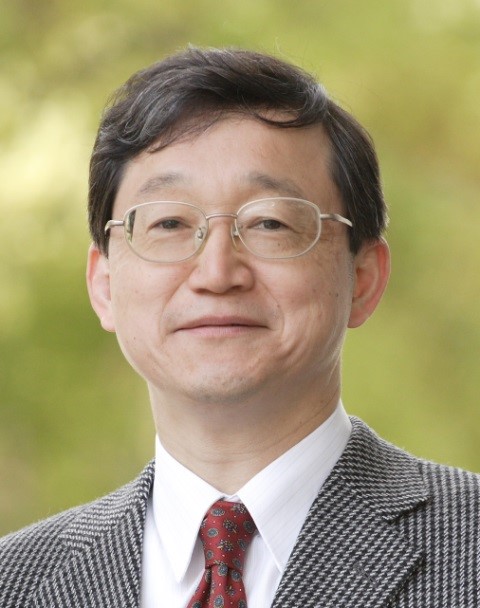Org. Synth. 2019, 96, 36-52
DOI: 10.15227/orgsyn.096.0036
Nickel-Catalyzed Cross-Coupling of 2-Methoxynaphthalene with Methyl 4-(5,5-dimethyl-1,3,2-dioxaborinan-2-yl)benzoate
Submitted by Yuki Kawashima, Takayuki Furukawa, Naoto Chatani* and Mamoru Tobisu
1
Checked by Takumi Fukuda, Masanori Nagatomo, and Masayuki Inoue
1. Procedure (Note 1)
A.
Methyl 4-(5,5-dimethyl-1,3,2-dioxaborinan-2-yl)benzoate (1). A single-necked, 1 L round-bottomed flask (29/32 joint) is equipped with a 5 cm Teflon-coated football shaped magnetic stir bar.
4-(Methoxy-carbonyl)phenylboronic acid (10.0 g, 55.6 mmol, 1.0 equiv) (
Note 2) and
2,2-dimethyl-1,3-propanediol (6.40 g, 61.5 mmol, 1.1 equiv) (
Note 3) are added. The flask is equipped with a connecting adapter (upper outer joint 29/32, lower inner joint 15/25) and a Dean-Stark condenser (15/25 joint), and the flask is charged with
toluene (450 mL) (
Note 4). The flask is immersed in a silicone oil bath and the bath is heated to 130 °C (Figure 1).
Figure 1. Reaction set-up for the formation of the boronic ester 1
The mixture is refluxed with stirring for 2 h under an argon atmosphere (
Note 5). The resulting colorless solution is allowed to cool to room temperature. The mixture is then transferred to a 1 L-separatory funnel and washed with tap water (80 mL x 3) and brine (70 mL x 1). The organic layer is dried over anhydrous
MgSO4 (15 g) (
Note 6) and filtered with pleated filter paper (#2 filter paper) to give a colorless solution, which is concentrated on a rotary evaporator (50 °C, 780 to 60 mmHg) and the resulting residue is then dried
in vacuo (0.80 mmHg) for 1 h. The resulting colorless solid is dissolved in 230 mL of
Et2O-
hexane (Notes
7 and
8) (4:1,
Et2O:
hexane) by warming the solution on a water bath (50 °C). The solution is concentrated on a rotary evaporator (50 °C, 780 to 400 mmHg) to provide a colorless precipitate. The precipitate is filtered through a Büchner funnel (11 cm diameter) with #1 filter paper and washed with cold
hexane (10 °C) (
Note 7), giving the title compound
1 as colorless plates (12.5 g, 50.4 mmol, 91%) (Figure 2) (Notes
9 and
10).
Figure 2. Methyl 4-(5,5-dimethyl-1,3,2-dioxaborinan-2-yl)benzoate
B.
Methyl 4-(naphthalen-2-yl)benzoate (2). A single-necked, 100 mL round-bottomed flask (29/32 joint, Flask A), a 200 mL round-bottomed Schlenk flask (29/32 joint, Flask B), a reflux condenser (15/25 joint), a connecting adapter (upper outer joint 29/32, lower inner joint 15/25) and a 4 cm Teflon-coated football-shaped magnetic stir bar are dried in an oven at 120 °C for 2 h. The side neck of Flask B is sealed with a rubber septum. The reflux condenser and the connecting adapter are connected to an argon/vacuum line and the bottom is capped with Flask A. The reaction set-up is further dried
in vacuo (0.80 mmHg) by heating with a heat gun and allowed to cool to room temperature (Figure 3).
Figure 3. Flask A with a reflux condenser
The oven-dried Flask B, equipped with a magnetic stir bar and a rubber septum, is placed in a glove box filled with argon. In the glove box,
Ni(cod)2 (960 mg, 3.49 mmol, 0.1 equiv) (
Note 11),
PCy3 (2.00 g, 7.13 mmol, 0.2 equiv) (
Note 12),
CsF (5.80 g, 38.2 mmol, 1.1 equiv) (
Note 13),
2-methoxynaphthalene (5.50 g, 34.8 mmol, 1.0 equiv) (
Note 14) and
methyl 4-(5,5-dimethyl-1,3,2-dioxaborinan-2-yl)benzoate (
1) (9.50 g, 38.3 mmol, 1.1 equiv) (
Note 15) are added to Flask B in that order. The remaining neck of Flask B is capped with a septum (
Note 16). Flask B is removed from the glove box and quickly connected to the reflux condenser by removing Flask A (Figure 4).
Figure 4. Flask A is replaced with Flask B
The reaction set-up is evacuated and backfilled with argon three times and the argon atmosphere is maintained throughout the reaction using an argon manifold system. The flask is charged with anhydrous
toluene (50 mL) (
Note 17) through the septum via a syringe, and then the Schlenk stopcock is closed. The resulting mixture is stirred for 10 min at room temperature, giving rise to a deep green solution (Figure 5). The flask is immersed in a silicone oil bath that has been pre-heated to 125 °C, and the mixture is refluxed with stirring for 17 h, giving a black mixture (Figure 6).
|
|
Figure 5. Initial color of the solution |
Figure 6. After refluxing for 17 h |
After cooling to room temperature, the mixture is filtered through a pad of Celite (
Note 18) (7 cm wide, 2 cm high) and the pad is washed with
EtOAc (400 mL) (
Note 19) to give an orange solution (Figure 7) (
Note 20). The resulting solution is concentrated on a rotary evaporator (50 °C, 780 to 60 mmHg) and dried
in vacuo (0.80 mmHg), which provides an amber solid (Figure 8).
|
|
Figure 7. Celite filtration |
Figure 8. After concentration |
The solid is dissolved in
dichloromethane (200 mL) (
Note 21), and silica gel (48 g) (
Note 22) is added to the solution. The mixture is concentrated on a rotary evaporator (38 °C, 780 to 250 mmHg). The resulting solid is purified by column chromatography on silica gel to give the title compound
2 as colorless solid (6.12 g, 23.3 mmol, 67%) (Figure 9) (Notes
23,
24, and
25).
Figure 9. Methyl 4-(naphthalen-2-yl)benzoate
2. Notes
1. Prior to performing each reaction, a thorough hazard analysis and risk assessment should be carried out with regard to each chemical substance and experimental operation on the scale planned and in the context of the laboratory where the procedures will be carried out. Guidelines for carrying out risk assessments and for analyzing the hazards associated with chemicals can be found in references such as Chapter 4 of "Prudent Practices in the Laboratory" (The National Academies Press, Washington, D.C., 2011; the full text can be accessed free of charge at
https://www.nap.edu/catalog/12654/prudent-practices-in-the-laboratory-handling-and-management-of-chemical. See also "Identifying and Evaluating Hazards in Research Laboratories" (American Chemical Society, 2015) which is available via the associated website "Hazard Assessment in Research Laboratories" at
https://www.acs.org/content/acs/en/about/governance/committees/chemicalsafety/hazard-assessment.html. In the case of this procedure, the risk assessment should include (but not necessarily be limited to) an evaluation of the potential hazards associated with
4-(methoxycarbonyl)phenylboronic acid,
2,2-dimethyl-1,3-propanediol,
toluene,
magnesium sulfate,
diethyl ether,
hexane,
bis(cyclooctadiene)nickel,
tricyclohexylphosphine,
cesium fluoride,
2-methoxynaphthalene,
ethyl acetate,
dichloromethane and silica gel.
2.
4-(Methoxycarbonyl)phenylboronic acid (98%) was purchased from Combi-Blocks and used as received.
3.
2,2-Dimethyl-1,3-propanediol (> 98.0%) was purchased from TCI and used as received.
4.
Toluene (> 99.0%) was purchased from FUJIFILM Wako Pure Chemical Corporation and used as received (checkers).
Toluene (> 99.0%) was purchased from Kishida Chemical Co. Ltd. and used as received (submitters).
5. After the reaction was stirred for 2 h, approximately 2 mL of water was collected.
6. Anhydrous
MgSO4 (95.0%) was purchased from FUJIFILM Wako Pure Chemical Corporation and used as received.
7.
Et2O (99.0%) was purchased from FUJIFILM Wako Pure Chemical Corporation and used as received (checkers).
Et2O (99.0%) was purchased from Kishida Chemical Co. Ltd. and used as received (submitters).
8.
Hexane (95.0%) was purchased from Kanto Chemical Co. Ltd. and used as received (checkers).
Hexane (95.0%) was purchased from Kishida Chemical Co. Ltd. and used as received (submitters).
9. When the reaction was carried out on a half-scale, 6.08 g (88%) of the product was obtained.
10.
Methyl 4-(5,5-dimethyl-1,3,2-dioxaborinan-2-yl)benzoate (1) has the following physical properties: mp 113-115 °C; IR (film): 2955, 1720, 1479, 1424, 1308, 1277, 1254, 1129, 1019, 708, 641, 498 cm
-1;
1H NMR
pdf(400 MHz, CDCl
3) δ: 1.03 (s, 6H), 3.78 (s, 4H), 3.91 (s, 3H), 7.86 (d,
J = 8.2 Hz, 2H), 8.00 (d,
J =8.7 Hz, 2H);
13C NMR
pdf(100 MHz, CDCl
3) δ: 21.9 (2C), 31.9, 52.1, 72.3 (2C), 128.5 (2C), 131.8, 133.7 (2C), 167.3; HRMS (DART)
m/z calcd for C
13H
18BO
4 [M+H]
+ 249.1293, found 249.1283; Anal. calcd for C
13H
17BO
4: C, 62.94; H, 6.91. Found: C, 62.77; H, 6.86.
11.
Ni(cod)2 (> 98%) was purchased from Strem Chemicals and used as received. It was vacuum-packed (Figure 10) and stored at 4 °C (checkers). The submitters stored it in a nitrogen-filled glove box at 0 °C.
Figure 10. Vacuum-packed catalyst
12.
PCy3 (> 94.0%) was purchased from Aldrich and was used as received.
13.
CsF (> 99.0%) was purchased from TCI and was used as received.
14.
2-Methoxynaphthalene (> 99.0%) was purchased from FUJIFILM Wako Pure Chemical Corporation and was used as received.
15.
Methyl 4-(5,5-dimethyl-1,3,2-dioxaborinan-2-yl)benzoate was dried in vacuo (0.80 mmHg) for 6 h and then transferred to an argon filled glove box.
16. The submitters reported that if the operation was performed outside of a nitrogen-filled glove box, the
Ni(cod)2 would be deactivated and this reaction would likely not proceed.
17. Anhydrous
toluene (99.5%) was purchased from FUJIFILM Wako Pure Chemical Corporation and dried prior to use on a Glass Contour solvent dispensing system (Nikko Hansen & Co. Ltd.).
18. Celite was purchased from FUJIFILM Wako Pure Chemical Corporation and was used as received (checkers). Celite was purchased from Kishida Chemical Co. Ltd. and was used as received (submitters).
19.
EtOAc (99.0%) was purchased from Kanto Chemical Co. Ltd. and was used as received (checkers).
EtOAc (99.0%) was purchased from Kishida Chemical Co. Ltd. and was used as received (submitters).
20. TLC analysis of the crude product was shown below. The Rf value of the product and boronic ester
1 in
hexane/
dichloromethane (1/1, v/v) was 0.21 and 0.10, respectively. The spot of the product can be viewed by fluorescence on silica gel 60 F
254 plates (TLC Silica gel 60 F
254, purchased from Merck KGaA) with UV light (254 nm).
Figure 11. TLC analysis of Step B reaction mixture
21.
Dichloromethane (> 99.0%) was purchased from Kanto Chemical Co. Ltd. and was used as received (checkers).
Dichloromethane (> 99.0%) was purchased from FUJIFILM Wako Pure Chemical Corporation and was used as received (submitters).
22. Silica gel (Silica gel 60, 0.040-0.063 mm) was purchased from Merck KGaA and was used as received.
23. Column chromatography was performed using 450 g of silica gel (Silica gel 60, 0.040-0.063 mm, purchased from Merck KGaA). It was wet packed in a 7 cm diameter column using
hexane/
dichloromethane (5/1, v/v) and the silica with the crude material adsorbed was loaded onto the column. The column was eluted with 2.5 L of
hexane/dichloro-methane (5/1, v/v) and then 5.0 L of
hexane/
dichloromethane (3/1, v/v) and lastly 10 L of
hexane/
dichloromethane (5/2, v/v). Fractions were collected in 500 mL bottles. Fractions No. 16 through 34 were combined and concentrated on a rotary evaporator (38 °C, 780 to 60 mmHg) and dried in vacuo (0.80 mmHg) at 80 °C for 12 h using a heat chamber.
Figure 12. TLC analysis of column fractions
24. When the reaction was carried out on a half-scale, 3.02 g (66%) of the product was obtained.
25.
Methyl 4-(naphthalen-2-yl)benzoate (
2) has the following physical properties: mp 154-156 °C; IR (film): 1716, 1601, 1436, 1275, 1190, 1108, 851, 818, 772, 693, 471, 438cm
-1;
1H NMR
pdf(400 MHz, CDCl
3) δ: 3.96 (s, 3H), 7.49-7.56 (m, 2H), 7.75-7.82 (m, 3H), 7.87-7.96 (m, 3H), 8.10 (d,
J = 1.6 Hz,1H), 8.14-8.17 (m, 2H);
13C NMR
pdf(100 MHz, CDCl
3) δ: 52.2, 125.2, 126.3, 126.4, 126.5, 127.3 (2C), 127.7, 128.3, 128.7, 128.9, 130.2 (2C), 132.9, 133.5, 137.3, 145.5, 167.0; HRMS (DART)
m/z calcd for C
18H
15O
2 [M+H]
+ 263.1067, found 263.1059; Anal. calcd for C
18H
14O
2: C, 82.42; H, 5.38. Found: C, 82.37; H, 5.55.
Working with Hazardous Chemicals
The procedures in
Organic Syntheses are intended for use only by persons with proper training in experimental organic chemistry. All hazardous materials should be handled using the standard procedures for work with chemicals described in references such as "Prudent Practices in the Laboratory" (The National Academies Press, Washington, D.C., 2011; the full text can be accessed free of charge at
http://www.nap.edu/catalog.php?record_id=12654). All chemical waste should be disposed of in accordance with local regulations. For general guidelines for the management of chemical waste, see Chapter 8 of Prudent Practices.
In some articles in Organic Syntheses, chemical-specific hazards are highlighted in red "Caution Notes" within a procedure. It is important to recognize that the absence of a caution note does not imply that no significant hazards are associated with the chemicals involved in that procedure. Prior to performing a reaction, a thorough risk assessment should be carried out that includes a review of the potential hazards associated with each chemical and experimental operation on the scale that is planned for the procedure. Guidelines for carrying out a risk assessment and for analyzing the hazards associated with chemicals can be found in Chapter 4 of Prudent Practices.
The procedures described in Organic Syntheses are provided as published and are conducted at one's own risk. Organic Syntheses, Inc., its Editors, and its Board of Directors do not warrant or guarantee the safety of individuals using these procedures and hereby disclaim any liability for any injuries or damages claimed to have resulted from or related in any way to the procedures herein.
3. Discussion
The Suzuki-Miyaura coupling of aryl halides and their equivalents with arylboronic acids is now recognized as one of the most powerful methods for forming aryl-aryl bonds, which are pervasive in a number of fields of organic chemistry ranging from pharmaceuticals to advanced organic materials.
2 If phenol-based electrophiles could be used as alternatives to aryl halides in the Suzuki-Miyaura reaction, it would significantly broaden the utility of this method, since phenols are naturally abundant chemical feedstocks and diverse derivatives are readily accessible by taking advantage of the unique reactivity profiles of phenols, such as S
EAr reactions. The cross-coupling of phenols can be classically achieved by their conversion to aryl triflates, thereby activating the C(aryl)-O bond toward oxidative addition to a metal catalyst. However, the use of fluorine-based leaving groups raises the issue of cost and waste, calling for the development of new catalytic methods that would permit the use of less expensive phenol derivatives. In this context, methoxyarenes would be more ideal coupling partners because they are easily accessible and halogen-free. However, the C(aryl)-O bond of methoxyarene derivatives is much stronger than that of aryl triflates, and therefore a methoxy group on the aromatic ring can be viewed as a non-innocent, unreactive functional group in cross-coupling reactions. Interestingly, Wenkert, in a pioneering study, reported on the nickel-catalyzed cross-coupling of methoxyarene derivatives with Grignard reagents as early as 1979.
3 However, these intriguing catalytic properties of nickel complexes failed to attract much attention for years. The past decade has witnessed tremendous advancements in the nickel-catalyzed cross-coupling of less reactive but more common phenol derivatives, such as aryl esters, carbamates, and ethers.
4In 2008, our group reported on the first Suzuki-Miyaura reaction of simple methoxyarenes using Ni(cod)
2/PCy
3 as the catalyst in the presence of a stoichiometric amount of CsF.
5 A methoxy group connected to a fused aromatic system (Table 1, entry 1 and 2) was efficiently replaced with a phenyl group. The advantage of using boronic esters instead of Grignard reagents as the nucleophilic coupling partner is demonstrated by the tolerance of functional groups, such as ketones and esters (Table 1, entry 3 and 5). Both electron-deficient (Table 1, entry 4 and 5) and -rich (Table 1, entry 6) boronic esters afforded coupling products in good yields. Sterically demanding boronic esters were also used successfully (Table 1, entry 7 and 8).
We subsequently developed a second generation catalyst consisting of Ni(cod)
2/ICy (1,3-dicyclohexylimidazol-2-ylidene), which exhibits a broader scope for aryl ether substrates.
6 This method is also applicable to benzyl methyl ethers. Mechanistic studies concerning this reaction have also been reported.
7 Although the Ni(cod)
2/ICy system is more active than the Ni(cod)
2/PCy
3 system, the Ni(cod)
2/ICy system is more sensitive to contaminating oxygen and moisture.
Since a methoxy group is tolerant to most of the common conditions used in organic synthesis, including the use of butyllithium, our method allows a methoxy group to serve as a viable handle for late-stage functionalization.
Table 1. a Ni/PCy3-Catalyzed Cross-Coupling of Methoxyarenes with ArylBoronic Esters
Reaction conditions: aryl methyl ether (0.5 mmol), boronic ester (0.75 mmol), Ni(cod) 2 (0.05 mmol), PCy3 (0.20 mmol), CsF (2.25 mmol), toluene (1.5 mL) in a sealed tube. bAll yields are isolated yield. c[Ni(cod)2] (0.10 mmol) and PCy3 (0.40 mmol) were used.
Appendix
Chemical Abstracts Nomenclature (Registry Number)
4-(Methoxycarbonyl)phenylboronic acid (99768-12-4)
2,2-Dimethyl-1,3-propanediol (126-30-7)
Ni(cod)2: Bis(cyclooctadiene)nickel(0) (1295-35-8)
PCy3: Tricyclohexylphosphine (2622-14-2)
CsF: Cesium Fluoride (13400-13-0)

|
Yuki Kawashima was born in Nagano (Japan). He graduated from Osaka University in 2018 with a B.Sc in Engineering, then continued his graduate studies at Osaka University under the supervision of Professor Mamoru Tobisu. He is currently working on developing new methods involving the activation of inert bonds. |

|
Takayuki Furukawa graduated from Osaka University in 2012 with a B.Sc. in Engineering. He then continued his graduate studies at Osaka University under the supervision of Professor Naoto Chatani, with a JSPS Research Fellowship (2014-2017). He received his Ph.D. for studies on nickel- and platinum-catalyzed C-H borylation reactions in 2017. During his Ph.D. studies, he joined Professor Dirk Trauner's group at LMU München in Germany as a visiting researcher and worked on total synthesis. He is currently working as a medicinal chemist at the Central Pharmaceutical Research Institute of Japan Tobacco Inc. |

|
Naoto Chatani received his Ph.D. in 1984 under the direction of Professors Noboru Sonoda and Shinji Murai. In 1984 he joined the Institute of Scientific and Industrial Research at Osaka University and worked in the laboratory of Prof. Terukiyo Hanafusa. After postdoctoral studies (1988-1989 with Professor Scott E. Denmark, at the University of Illinois, Urbana-Champaign), he moved back to Osaka University and was promoted to Associate Professor in 1992 and to Professor in 2003. His research interests center on the development of new synthetic methodologies with particular emphasis on C-H activation. |

|
Mamoru Tobisu received his Ph.D. from Osaka University under the direction of Professor Shinji Murai (2001). During his Ph.D. studies, he also worked with Professor Gregory C. Fu at the Massachusetts Institute of Technology for five months as a visiting scientist (1999). Following a period at the Takeda Pharmaceutical Company (2001-2005), he started his academic career at Osaka University in 2005 as an Assistant Professor with Professor Naoto Chatani. He was appointed as an Associate Professor at the Center for Atomic and Molecular Technologies at Osaka University in 2011 and promoted to Professor at the Department of Applied Chemistry, Osaka University in 2017. His research focuses on development of new organic transformation, as well as new materials with interesting properties. |

|
Takumi Fukuda was born in Chiba (Japan). He graduated from Tokyo University in 2017 with a B.S. in Pharmaceutical Sciences. He is continuing his graduate studies at Tokyo University under the supervision of Professor Masayuki Inoue. His research interests are in the area of the total synthesis of natural products. |

|
Masanori Nagatomo was born in 1983 in Miyazaki, Japan. He received his B.S. (2007) and M.S. (2009) degrees at Tokyo University of Science under the direction of Professor Tadashi Nakata. He obtained his Ph.D. (2012) from the University of Tokyo, where he conducted the research on total syntheses of complex natural products under the supervision of Professor Masayuki Inoue. In 2012, he worked with Professor Phil S. Baran at The Scripps Research Institute. In the same year, he was appointed as Assistant Professor in the Graduate School of Pharmaceutical Sciences at the University of Tokyo and promoted to Lecturer in 2018. His research focuses on the development of novel synthetic methodology and applications to the multistep synthesis of complex molecules. |
Copyright © 1921-, Organic Syntheses, Inc. All Rights Reserved